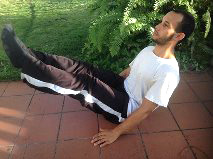January 2015
Accountability: Even the Fitness Industry Needs It
by Nick A. Titley, M.S., NPI-Certified Posture Specialist
It’s the start of a new year and many of the old year’s habits need to be left behind. How do you know when a fitness professional is performing an exercise in good form and body alignment? You don’t; If you’re not exercise savvy then the likelihood of being misled is high. Fitness organizations and professionals need to be more aware of form and body alignment when posting exercises.
Last year, after opening a monthly newsletter from a major fitness organization I noticed the model’s posture and body alignment was off. Her head and neck were lurching forward as she sat up, frozen in place. The fitness model from the newsletter was trying to work her abdominals while simultaneously putting her neck and spine at risk. It wasn’t the first time I saw something like this; I’ve seen professionals performing techniques with improper form and body alignment. It’s time that organizations and professionals in the fitness industry take account for these problems. The general public will emulate these techniques.
According to an article by Nikitow Chiropractic, one of the most common posture problems is forward head posture (FHP). Repetitive computer, TV, video game, phone and backpack usage, alongside poor exercise form can force our bodies to adopt this problem. Repetitively lurching the head and neck forward can strengthen nerve and muscle pathways to move that way more readily. In short, repetition of forward head movements combined with poor ergonomic postures can lead to FHP. Was the professional, and the organization, aware of FHP when they posted that image?
 |
 |
| Incorrect |
Correct |
Dimitri Onyskow and I spoke about the problem. As the Educational Fitness Solution’s Director of Academic Relations, he deals with these issues: “I think most organizations do not want to acknowledge the fact that they have been promoting poor technique,” he says, “If they did, they would be admitting they were wrong. Instead, they choose to ignore it in hopes that no one else will notice.”
Dimitri says that the problem exists in major fitness organizations that offer corrective exercise programs: “What most don’t understand is if a client is doing a ‘corrective exercise’ movement in poor alignment, all they are doing is adding strength to an already imbalanced frame. And this will lead to injury down the road. It is imperative that proper technique is taught throughout.”
Michele, a fitness club manager, also had a similar experience and shared her utter distaste for some major fitness brands. She says that people are quick to follow these teachings even if they are dangerous. She believes that one of the major problems with these brands is the bad form of their followers: “They often have people doing pointless motions with incorrect form and at ridiculous weights.”
Michele believes that many of the people following routines from these brands have no clue what they’re doing and they think their form is correct. Many are closer to a hospital visit than achieving their results and refuse help when approached about their form.
So can you tell when you’re being misled? It’s difficult to tell, so sometimes you need to seek a second opinion. Keep in mind that every trainer and fitness organization isn’t trying to mislead you, but even the experts get it wrong sometimes. If you’re unsure about a technique, don’t feel it working, or you’re concerned about the danger level then by all means ask questions. Always ask questions, research the topic and pay attention to who is providing the advice.
Good form and proper body alignment should be the goal of every exercise. Organizations and professionals in the fitness industry need to be aware of their form and body alignment while performing exercises. The general public won’t know the difference between right and wrong. It’s up to the fitness industry to teach the public the correct methods and to be accountable for their actions.
References:
- Nikitow, D. (2014). Damaging effects of forward head posture. Retrieved from denvertechchiro/files/fhp_revised.pdf
- Michele. Personal interview. 7 January 2015
- Onyskow, Dimitri. Personal Interview. 6 January 2015
|
